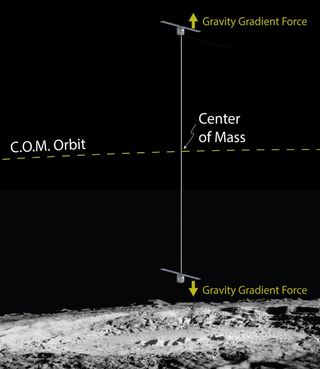A Miniature Lunar Sky Crane Could Help Solve the Mystery of the Moon's 'Tattoos'

A novel mission concept from NASA would lower a small satellite toward the surface of the moon on a 112-mile-long (180 kilometers) tether. One of the mission's goals would be to uncover the cause of strange, swirling patterns found in more than 100 locations on the lunar surface.
In May, NASA announced that it would invest funds in 10 mission concepts involving small satellites called cubesats. Recently, the agency released more details about one of those concepts — the Bi-sat Observations of the Lunar Atmosphere above Swirls (BOLAS) mission concept.
The mission would involve two small satellites, each about the size of a shoebox, connected vertically above the lunar surface by a long, thin tether, like some kind of miniature sky crane. The cubesat at one end of the tether would orbit the moon at an altitude of about 118 miles (189 km), which would place the second cubesat about 6 miles (9.6 km) above the lunar surface. From that position, the satellite could study those strange features in detail. [Amazing Moon Photos from NASA's Lunar Reconnaissance Orbiter]
To put a lone satellite into orbit around the moon at an altitude of 6 miles (9.6 km) above the surface, for an extended period of time, would require "a prohibitive amount of fuel," according to the statement. This is largely because of irregularities in the moon's gravity along its surface, which can push or pull a satellite out of orbit.
Tethered satellites are therefore "a very natural approach for targeting lunar science," Michael Collier, a BOLAS co-investigator, said in the statement. Collier has been studying tether-based lunar missions since 2015 and called the BOLAS mission concept "groundbreaking."

Lunar swirls
The satellite would be able to study "lunar swirls," or regions of light-colored material on the moon's surface that, in addition to their lighter color, appear to be less weathered than the dark regions around them. Scientists think the light regions form because of magnetic material in the lunar crust, which would create magnetic-field lines and attract more magnetic material on the surface.
But there are multiple hypotheses about how the magnetic fields form, how the magnetic material on the surface gets sorted and why the swirls appear less weathered than nearby areas. One hypothesis suggests that comets could have deposited the magnetic material that creates the magnetic fields. And perhaps the magnetic fields protect the areas from the harsh solar wind (a steady stream of particles ejected into the solar system by the sun), which explains their relatively pristine condition. With no atmosphere to protect it, the solar wind can pummel the lunar surface continuously; however, "several phenomena can cause material exposed to space to change both physically and chemically," according to the statement. Thus, the effect of the solar wind might not fully explain the condition of the swirls.
Get the Space.com Newsletter
Breaking space news, the latest updates on rocket launches, skywatching events and more!
NASA's Lunar Reconnaissance Orbiter mission has been able to provide some information about the cause of the lunar swirls, but not enough to rule out any of the leading theories, officials said in the statement. Collier said he thinks the BOLAS mission "could provide the data the scientific community needs."
The lunar swirls aren't the only focus of the BOLAS mission. The dual spacecraft would also investigate the hydrogen cycle on the lunar surface. The moon's supply of hydrogen could one day be used to fuel rockets launched from its surface, traveling to distant destinations like Mars. The BOLAS mission would gather data about the mechanisms that can implant hydrogen on the moon's surface, and how those mechanisms depend on various physical features of the surface, the space above it and even things like time of day.
"There is a lot of science you can do with this instrument suite," said Timothy Stubbs, principal investigator for BOLAS at NASA's Goddard Space Flight Center.
Follow Calla Cofield @callacofield. Follow us @Spacedotcom, Facebook and Google+. Original article on Space.com.
Join our Space Forums to keep talking space on the latest missions, night sky and more! And if you have a news tip, correction or comment, let us know at: community@space.com.

Calla Cofield joined Space.com's crew in October 2014. She enjoys writing about black holes, exploding stars, ripples in space-time, science in comic books, and all the mysteries of the cosmos. Prior to joining Space.com Calla worked as a freelance writer, with her work appearing in APS News, Symmetry magazine, Scientific American, Nature News, Physics World, and others. From 2010 to 2014 she was a producer for The Physics Central Podcast. Previously, Calla worked at the American Museum of Natural History in New York City (hands down the best office building ever) and SLAC National Accelerator Laboratory in California. Calla studied physics at the University of Massachusetts, Amherst and is originally from Sandy, Utah. In 2018, Calla left Space.com to join NASA's Jet Propulsion Laboratory media team where she oversees astronomy, physics, exoplanets and the Cold Atom Lab mission. She has been underground at three of the largest particle accelerators in the world and would really like to know what the heck dark matter is. Contact Calla via: E-Mail – Twitter
